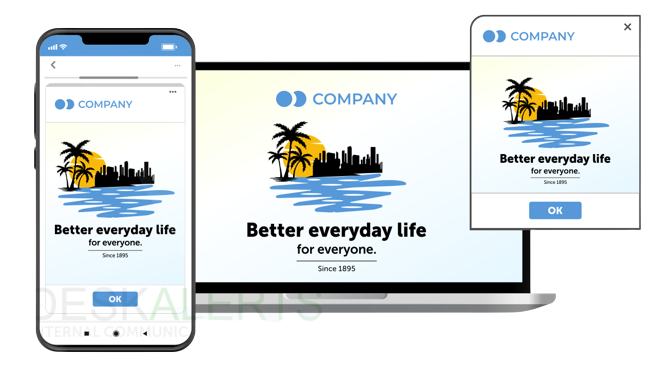 Developing a brand is hard work, and can take a lot of time and cost a lot of money. When it comes time to launch your brand, it’s important not to overlook a critical category of stakeholders: your employees.
Developing a brand is hard work, and can take a lot of time and cost a lot of money. When it comes time to launch your brand, it’s important not to overlook a critical category of stakeholders: your employees.
So what is the definition of internal branding? The internal branding meaning is about connecting your employees to the company’s external brand, showing them what the brand means and to ensure they both understand and are committed to the company’s mission. This includes ensuring employees are aligned with and understand organization’s vision – that they know how and why this branding has been adopted.
The differences between internal and external branding
External branding is the parts of your company that the public can see. It’s represented in things like your logo, your corporate colors, your website, brochures, social media and print designs. The visual aspects of your brand are combined with the values you espouse and the experience you aim to deliver to your customers and stakeholders when they interact with your organization.
Internal employer branding helps you to define the attributes of your brand so that your employees can deliver your products and services in a persuasive way, and in a way that differentiates your company from your competitors.
Why is internal branding important?
Internal branding helps to strengthen your company’s overall brand by encouraging your employees to embrace your company’s values. In doing this, it will translate to the way your employees interact with your customers and stakeholders.
Your internal branding campaign should reflect what you are doing outside of the organization, and this includes the stylistic elements of your branding as well as the overall way in which your company represents itself.
Not only will this keep your employees familiar with the brand identity, but incorporating it in your internal efforts will also help to ensure that the brand is authentic – not just something you put on “for show” for the outside world.
Your internal branding strategy should be every employee’s priority and they should live the brand. When your employees are emotionally invested in your brand it’s likely they will be more loyal to the company, be more productive and inspired and be motivated and innovative.
A strong internal brand will help you to attract employees that align with your company beliefs and values.
According to the Edelman Trust Barometer 2022, 60% of people choose a workplace that aligns with their own values and beliefs.
This also helps transform your employees into “brand ambassadors” - not only are they the public face of your organization, but they represent the brand in all aspects of their life. When they believe in the brand they’re more likely to advocate for the brand, share the company’s successes on social media and refer business to the company.
A Neilson study found that 84% of people trust recommendations when they come from their friends, family members and colleagues compared with other types of marketing.
If you want to project your organization as having a strong environmental ethos, for example, your employees planting trees and undertaking to cut the carbon footprint of the organization is a good way to get them on board to live your brand values.
The best practices for internal branding
Some of the world’s most successful companies have a strong internal branding process and are able to take their employees along on the journey with them. They do this in the following ways:
1. Develop an internal branding strategy
Your internal branding strategy should set out a clear company vision and purpose. Your senior management team should be involved in developing this and be committed to putting the words into action and modeling your ideal values and behaviors.
Other things that should be included in the strategy are:
- Determining your objectives and set up metrics for measurement.
- How you will your branding with employees.
- Translating your external branding to your employees in a way that they understand it and can relate to it so they deliver it in their everyday roles within your company.
- Aligning the internal branding with external efforts.
- Encouraging employee participation and dialogue around what the branding says to them.
- Establishing processes to have employee brand ambassadors to reflect your branding.
2. Delivering your internal branding campaign
Based on the actions that you outline in your internal branding strategy, you can now deliver internal branding campaigns. These processes should be followed to ensure maximum benefits.
- Be consistent, clear and authentic with your messages. If you are none of these things, it will show.
- Be clear about why you want to change your branding.
- Build excitement and buzz around your brand among your employees via internal marketing – try to make a personal connection with them to do this. Once they are enthusiastic about it, you’ll need to find ways to keep the momentum going.
- Make sure you are launching your new branding at the right time. For example if you’ve just laid off a percentage of your workforce, your efforts to rebrand may fall flat and those remaining employees may be resentful of money spent on branding that cold have been used to save jobs.
- Look for new and innovative ways to reinforce your branding throughout your company. Think beyond letterhead and business cards and a logo on the wall of your lobby.
- Train your employees to live and breathe your brand by giving them tools and empowering them to model the correct behaviors and mindset.
- Give employees incentives and reward and recognize their efforts when actively promoting and living the brand identity.
- Don’t just set and forget your branding – keep monitoring it and updating it to ensure it represents your company in the best way possible.
- Listen to your employees – they’re the ones at the coalface of your operations. Their opinions and feedback can help save you from embarrassment.
3. Important aspects of an internal branding campaign
These are the aspects of your internal branding campaign that should be utilized to ensure your employees become more focussed on customer outcomes and are committed to developing your brand’s culture:
- Vision, mission and values
- Standards of service
- Communication and key messages
- Training employees in your brand
- Measuring success
- Evaluating the campaign

Benefits of an internal branding strategy
There are many ways that an internal branding strategy can benefit your business. This includes:
1. Improving your hiring and retention
The ultimate goal is to have elements of your branding translate into behaviors modeled by your staff. This will also help you to attract and retain the types of employees that display the characteristics and attributes that are synonymous with your brand identity.
2. Fostering a relationship between employees and your branding
By creating brand awareness, your employees will understand your brand and how your clients view it, and will become its custodians. Your employees in effect become an extension of your brand. Internal branding and employee engagement go hand in hand: when you build a strong workplace culture as part of your internal brand, your levels of employee engagement will rise, which has overall positive benefits for your company.
3. Linking your internal and external branding
It’s important that your employees hear the same messages inside the organization that you are sharing with the outside world. Unfortunately the reality is often the opposite in many companies - a failing in brand awareness. When employees hear you say one thing to the outside world and another thing internally, they can feel jaded and cynical and develop a mistrust in the integrity of your company.
4. Connecting strategies to people
Strategies can look great on paper, but when it comes to putting them into practice they might not always translate. When you get your branding right it will sync well internally and ill be an idea that your employees want to see succeed.
5. Creating brand advocates
Word of mouth is one of the most powerful ways to market your products or services. What better way than to have your own employees advocate for your company because they identify with and believe in the brand?
6. Ensure your employees are delivering a branded customer experience
When your employees completely understand the ethos of your brand, the way they interact with customers will become part of the brand’s identity. When they are emotionally connected with the brand they can then connect with people on the outside of the organization.
7. Distinguish your company from the rest
Strong internal brand management will cement your reputation and the unique aspects of your organization that make it attractive to both internal and external clients.
How DeskAlerts can help with your internal branding campaign
 DeskAlerts is a powerful internal communications solution that will help you bring your internal branding campaign ideas to life. This innovative software enables you to deliver information to your employees quickly and easily across any devices, via an array of channels including pop-up notifications, scrolling desktop tickers, mobile alerts, SMS messages.
DeskAlerts is a powerful internal communications solution that will help you bring your internal branding campaign ideas to life. This innovative software enables you to deliver information to your employees quickly and easily across any devices, via an array of channels including pop-up notifications, scrolling desktop tickers, mobile alerts, SMS messages.
Content that reflects your internal branding campaign can be sent via DeskAlerts in the form of corporate wallpapers, corporate screensavers, corporate lockscreens and digital signage. Essentially you can turn any screens in your organization into professional looking digital billboards reflecting your corporate branding.
DeskAlerts offers customisation options for internal branding in the form of custom skins and a skin editor. Custom skins for message templates can be created by the DeskAlerts team to reflect align with your corporate branding to ensure a consistent look and feel. The skin editor is an add-on feature that will allow you to create, edit and send many template skins as you like that are made in accordance with your design guidelines.
***
Internal branding processes can take a while to figure out and implement, but are worth the time and effort and will help you to have a cohesive, high-performing team and make you stand out as an employer of choice.
Frequently asked questions
Why is internal branding so important?
Internal branding helps to strengthen the branding the company uses with external audiences, and helps to boost your internal culture.
What is internal branding example?
An example of internal branding is when you actively turn your employees – not just those in customer-facing roles - into brand ambassadors who will champion your company.
What makes a good brand campaign?
A good brand campaign is one that helps to tell your company’s story and get its message across to an audience in a way that is aimed at increasing brand awareness.
What is internal brand culture?
Internal brand culture is where the external brand of your company influences the culture within the company so that values are aligned.
 Caroline Duncan
Caroline Duncan
 Developing a brand is hard work, and can take a lot of time and cost a lot of money. When it comes time to launch your brand, it’s important not to overlook a critical category of stakeholders: your employees.
Developing a brand is hard work, and can take a lot of time and cost a lot of money. When it comes time to launch your brand, it’s important not to overlook a critical category of stakeholders: your employees.
 DeskAlerts is a powerful
DeskAlerts is a powerful 




